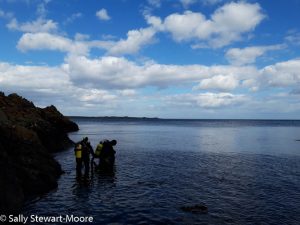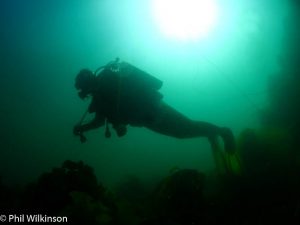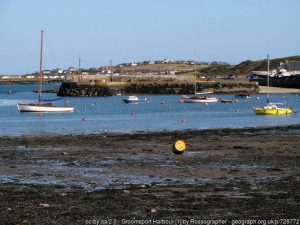Turn off the A2 Warren Road Head for National Trust Orlock Point. Exact parking location is 54.668970, -5.573830 (Google maps). Follow the footpath for ~200 metres to reach the entry point. Note that the footpath is uneven and narrow. The entry point is a small stony beach, on the north side of a high rocky outcrop. Enter the water here (easiest at high water) and follow the rocky wall out to the point. Drop down here and swim around the corner, following the wall in a northerly direction.
The nearest public toilets are near Main Street, Groomsport.
Nearest tank filling: DV Diving, Newtownards.
- Entry and exit over slippery boulders can be quite difficult causing a slip and trip hazard.
- There can be strong currents further from the shoreline.
- Due to possible surge, there is a slight risk of being pushed against the rocks.
A really interesting and diverse shore dive. Finning out east to ‘the point’ there are boulders, rock, sand and mixed seaweed. Heading north from the entry point (at 54.671221, -05.574086) there is a lovely wall at a slightly acute angle towards the seabed. At the top of this wall is kelp. Further down there are numerous sea squirts, soft corals, anemones and crustaceans such as velvet swimming crabs. Finning north, there are further points of interest with smaller walls and a seabed that is generally sandy with large and smaller pebbles. At ~54.671540. -05.574155 there is a swim through. This can be difficult to find even in good visibility. Look out for a sandy seabed with large and smaller pebbles and sea spaghetti dipping into a dark cave entrance. The entrance is ~1m across and ~1m high. The main ‘chamber’ of the swim through is ~1.5 wide and 1.8m high. The swim through walls and ceiling are covered in highly abundant baked bean sea squirts, giving the main chamber a reddish glow under torch light. There are also crustaceans such as spiny squat lobsters and velvet swimming crabs. The swim through is ~5m in length at a linear depth of ~6m. At the end of the swim through there are silty boulders and a chimney (vertical) exit to ~2m of fairly open kelp. The swim through has quite a silty seabed with smaller pebbles and sand. If you are the first diver there, it is fantastic, however the visibility quickly deteriorates due to finning and disturbance of the silt. The remainder of the dive is normally heading south to the point and then east to a slippery exit over the boulders at 54.670990, -05.575001 (from my experience, a good time to remember to keep your mask on and reg in, until you’re on dry land!)
At the walls and swim through there are soft corals, numerous crustaceans, wrasse, anemones (including the white striped anemone Actinothoe sphyrodeta) and large, dense colonies of the baked bean sea squirt Dendrodoa grossularia. A white variety of elephant’s hide sponge Pachymatisma johnstonia is found on the cave walls.
View all species records from this site
A link to the dive site location on the NBN Atlas Northern Ireland website, showing all species records from within a 1km boundary of the site centroid. Any new species records from the site submitted to Seasearch, iRecord, CEDaR Online Recording or iNaturalist will appear here- In an emergency call 999 or 112 and ask for the coastguard.
- Follow VHF radio Channel 16 (156.8 MHz), the international distress frequency.
- Find nearest defibrillator (AED) here
- Groomsport/Donaghadee Harbour Master: 028 9188 2377



































Leave a Comment
Dived here recently? Then let other divers know about this site from your experience!